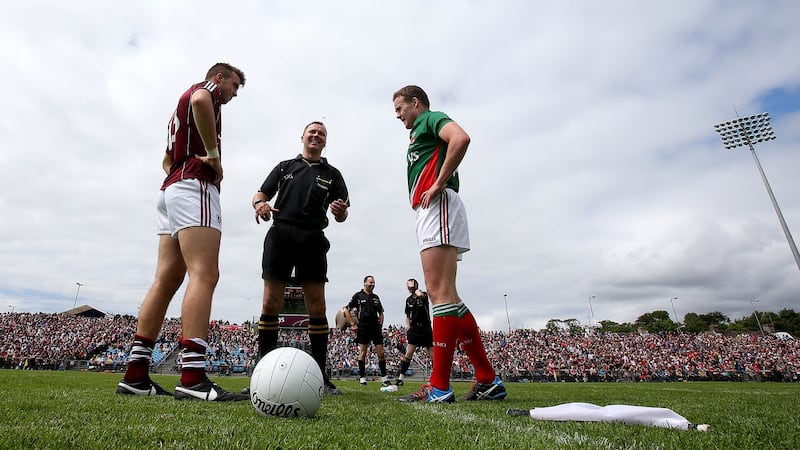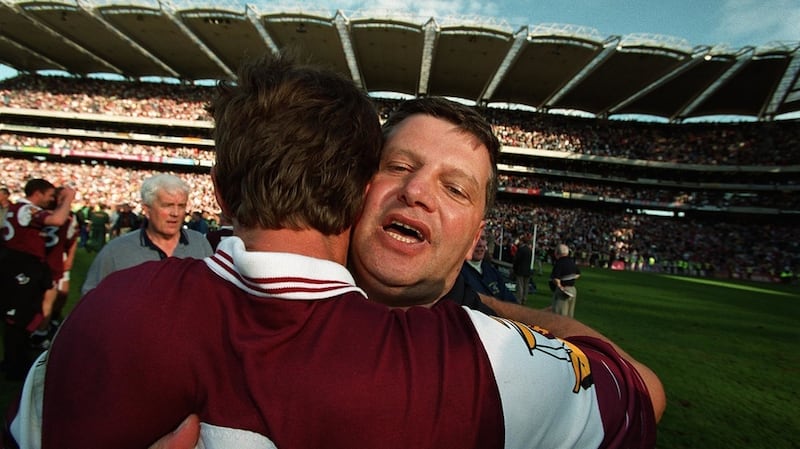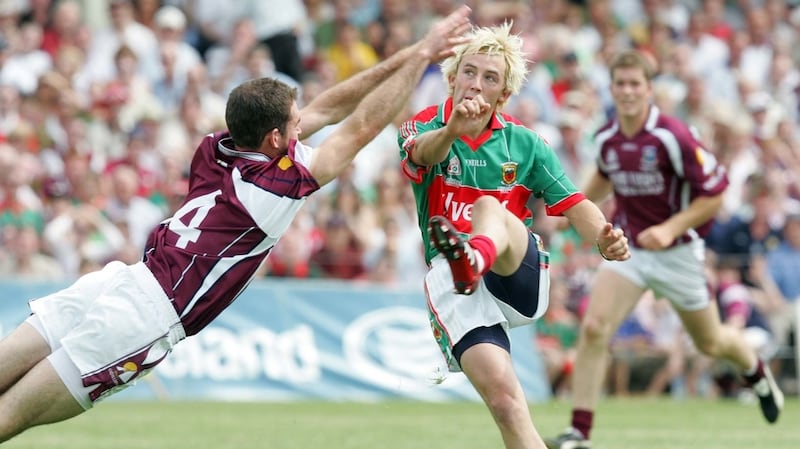When John O’Mahony sat before the interview panel for the position of Galway senior football manager, he knew that one question was inevitable.
“Why should we give this job to a Mayo man?”
Now in the 20th anniversary year of that famous maroon All-Ireland season, he laughs when he recalls the response: “I effectively said: ‘I presume it’s because ye want to win an All-Ireland’. It was probably a cheeky answer to give but it worked out all right.”
O’Mahony’s influence in shaping the narrative of the Connacht game is without peer. By the time he managed Galway to the All-Irelands of 1998 and 2001 (they lost the 2000 decider after a riveting replay with Kerry), he had, in 1989, returned his native Mayo side to a first September since 1951 and in 1994 guided Leitrim to its lone provincial championship summer since 1927. This winter, he is back in football boots, assisting the Leitrim squad.
Tomorrow, he will be in the crowd in Salthill for the latest instalment of Mayo-Galway and one that feels is significant. Galway are setting the pace in Division One for the first time in many years while Mayo are regrouping for another full-on assault on the All-Ireland summit. It’s an Old Firm day that neither county will want to cough up.
But Galway-Mayo is the most unique rivalry in Gaelic games for it has been a border rivalry celebrated for a complete absence of rancour. If Armagh-Tyrone is perceived to be at one end of the spectrum, then Galway-Mayo is at the other.
There's a wonderful story in James Laffey's new book Will Galway Beat Mayo?: How a 1960s GAA Rivalry Reawakened The West.
On All-Ireland final day of 1966, Tull Dunne, Galway’s secretary, its godfather and its conscience all rolled into one, had a conniption when he found out that Jimmy Duggan, his teenage protégé, wasn’t in the dressing room with less than half an hour to throw-in.
A search party was sent out around the stadium and Duggan, raised in Claremorris, schooled in St Jarlath’s of Tuam and whose father Frank played for Galway in 1938, was discovered on the sideline, screaming for the Mayo minors who were in a pitch battle against Down.
“These lads were all my friends,” Duggan told Laffey. “Eugene Rooney, the goalie from Kiltimagh, would be over in my house all the time. I was desperate for them to win and I didn’t even notice that the rest of my team-mates had gone into the dressing room.”
Ninety minutes later, Duggan had won his first (and last) senior football medal as Galway completed the three-in-a-row.
No rancour
Johnny Carey, the Mayo player who had marked Duggan in that summer’s Connacht final, was in the Gresham Ballroom on Holloway Road that evening. Sometime after 11 o’clock, word of the All-Ireland scorelines travelled through the Irish haunts of London. Galway were senior champions. Mayo were minor. The dancehall was packed with emigrants from both sides of the border and they delighted in a success that seemed mutual.
Is it still so straightforward? James Laffey conducted dozens of interviews with players from the 1950s and 1960s.
“All were at pains to say that there was no rancour. There was no quarter asked for on the field but there was a great respect and friendships there.”

And it is difficult to recall any incident of Mayo-Galway football brawls. It isn’t their style. They just played – and still do.
For Laffey, there were several key considerations in the evolution of the relationship. The St Jarlath’s factor was crucial. Fr JJ Cribben told him that at the 1964 Connacht minor final between Galway and Mayo, he counted 17 players from the school on the field. Five of St Jarlath’s 1960 Hogan Cup team played on Galway’s three-in-a-row team. Patterns of the expressive football coached at the school could be seen in the attacking play of both senior teams.
“If you look at those great Hogan Cup teams it broke down half and half between Mayo and Galway. The friendships between the likes of John Morley and Enda Colleran and Johnny Geraghty who were on the 1960 team was very strong. Then you look at Pat Donnellan: his mother was Mayo and he ended up marking his first cousin the 1969 Connacht final – Ted Griffiths. Pat himself is married to a Mayo woman. There are so many connections, let alone the number of Mayo people living in Galway city.”
John Keenan, one of Galway’s mainstays, had his imagination fired by the Mayo All-Ireland team of 1951.Years later, Conor Mortimer, a Jarlath’s alumni from Shrule would have looked up to Pádraic Joyce and Michael Donnellan.
“Just a different class of footballer,” Mortimer says. “ And they happened to be from Galway in our time. And then you are on the same pitch as them and you move past that and then it’s: ‘we can beat these boys’. We had the love-to-beat kind of rivalry rather than we hate them.”
The key common experience of both counties in the 1950s and 1960s was emigration. During Galway’s three-in-a-row years, Mayo habitually gave them their toughest game of the campaign. The richness of both football teams contrasted with the draining of towns and townlands. Close on 40,000 people left Galway and Mayo between 1951-66, according to Laffey.
Jagged edge
In his research he came across a Tuam Herald story reporting on the departure of a young girl, the ninth member of her family to leave. The big summer football matches were vibrant social occasions; being there seemed like a celebration in itself. Maybe it mattered for the morale of this loose place called "The West" that one of the teams was capable of winning at a national level.
John O’Mahony’s appointment with Galway sharpened the rivalry in a way that hadn’t been witnessed since the 1960s. Coming into 1998, Mayo had lost the previous two All-Ireland finals. Then Galway came screaming across the sky as though to show them how it was done.
For all the family and friendships and historical ties, that had to smart. And the rivalry has had a more jagged edge since. In 1999, Mayo came to Tuam and dumped Galway out of the All-Ireland.
“And that win was celebrated on the pitch by Mayo the same as if it was an All-Ireland,” remembers O’Mahony.
“I think Mayo bombed out against Cork later that year. And I don’t know but maybe Galway’s beating of Mayo last year and then flatlining against Tipperary . . . there is so much intertwining. But yeah, there is a jagged edge because both counties are absolutely striving to get to the top table and to outdo each other.”

O’Mahony defines the football relationship between the counties as “ a fierce rivalry but with great respect”. But he points out that it was probably easier for players and supporters to be friendlier in the 1970s and 1980s when they were all caught in the same struggle of trying to recapture something lost.
Jim Carney, the former RTÉ and Tuam Herald journalist is from Milltown and feels the contemporary Mayo-Galway rivalry is a slippery one to get a handle on. All of the celebrated characteristics are there: family ties, friendships, a commonality of world view and experience. But deep down, do they really wish for the other county to be successful once they are beaten?
“It is a difficult one to answer. In the three-in-a-row era it was certainly a very healthy and friendly rivalry. There is a certain bit of . . . not delight that Mayo haven’t got there yet . . . but I get the sense that Galway is not as sympathetic to Mayo as they would have been in the old days.”
That would be understandable. Galway sort of gradually faded out of the national conversation since that fabulous O’Mahony team won in 2001. No maroon side has made it past an All-Ireland quarter-final since.
National cause
They’ve had to suffer through the frustration of five Mayo Connacht championships on the trot and watch as Mayo’s incredibly dramatic brushes with near All-Ireland glory became a sort of national cause.
Jim Carney was in Pearse Stadium on the day of the 2013 encounter, when Mayo swept into Salthill and eviscerated Galway on a score of 4-16 to 0-11 and detected an edge in the stadium afterwards that he hadn’t witnessed before.

“ It was just different. I do think a bit of badness has crept in.”
And even when Galway responded to that positively, by beating their rivals in the last two Connacht championships, Mayo dusted themselves down by popping up in All-Ireland finals anyhow.
It was easier in the knockout days, when the loser was done for the summer. That old order has been disturbed. Conor Mortimer won four Connacht championships with Mayo and finished as the county’s all-time top scorer. He reckons that any border game he played in was “feisty”.
“I gave it up to Galway and they gave it back to me on and off the pitch. But it wasn’t in a hateful way. You get plenty when you are playing. But that was from every team. I’d have a lot of friends from Galway. I think Mayo-Galway, there wouldn’t be a huge amount of hatred. One or two players may have different opinions but in the ethos of the teams, definitely not.
“I wouldn’t say it’s a friendly rivalry but Galway were always the best team for us to beat. The most satisfying. Galway-Mayo Connacht finals were what we grew up with. Which is not to disrespect the other counties . . . it’s just the two counties have won the most and that comes with it.”
He pauses for a second when asked if he thinks Galway football as an entity would like to see Mayo actually get there and win the All-Ireland.
“The players . . . no. Some of the supporters and stuff, I’d imagine so, yes. But it is very difficult . . . like if you win a Connacht championship and the team you beat goes on to win an All-Ireland . . . of course you won’t be supporting that team.”
Finely balanced
The rivalry seems finely balanced this weekend. It’s just the third game of the league season but Galway have marked their return to the top flight by looking as if they belong. This Mayo team is extraordinary and has put in a lot of miles in trying to get to Babylon.
It’s only a matter of time before the power swings south again. It has always been cyclical. Mayo’s greatest fear must be that this current team would dismantle having come so close while some future Galway side could just swoop in from nowhere to claim another title with the seeming effortlessness of the 1998 bunch.

Even since then, the game has become faster; time is more precious, the stakes are more serious, the commitment is total. The thing that Galway and Mayo have most in common just now is that they are standing in one another’s way.
It stands to reason that there is going to be friction.
“What we are talking about here is human nature,” says O’Mahony.
Both counties want the same thing. The rivalry might not be quite as warm anymore but it is fiercely alive.












